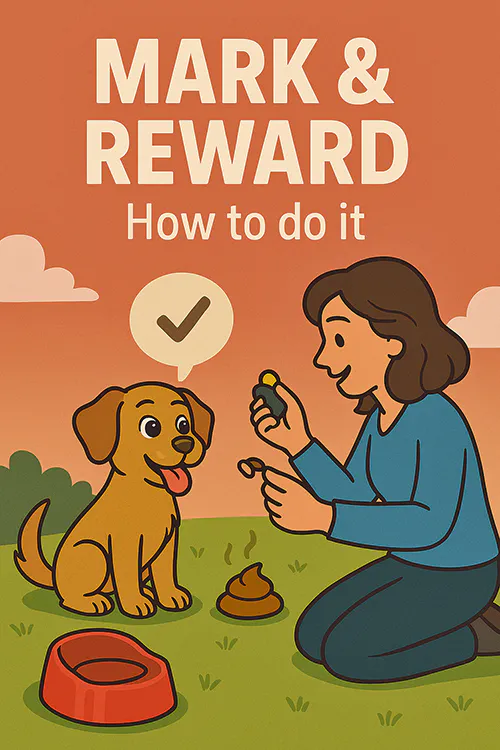
In the world of dog training, few techniques are as simple and universally effective as “mark and reward”. At its heart, it’s about communication, giving your dog a clear signal the instant they’ve done something right, and then following it with something they value. Done well, it bridges the gap between action and understanding, turning good behaviour into a habit your dog offers willingly.
The “mark” is a precise cue that tells your dog, “Yes, that’s it”. It can be a click from a clicker, a short word like “Yes!” or “Good!” spoken in a consistent tone, or even a visual signal for hearing-impaired dogs. The key is that it’s always the same and always delivered at the exact moment the desired behaviour happens. This timing is critical. Dogs live in the moment, and their brains connect cause and effect in seconds. If your mark comes late, you risk rewarding something else entirely.
The “reward” is what makes the behaviour worth repeating. For most dogs, that’s small, high-value treats that can be delivered quickly. For others, it might be a favourite toy, a quick game or enthusiastic praise. The reward must follow the mark immediately, so the dog learns that the mark predicts something wonderful. Over time, the mark itself becomes reinforcing, a promise your dog trusts.
How to do it
To start, choose your marker and practise your timing without the dog. If you’re using a clicker, click and then immediately get a treat from your pocket. If you’re using a verbal marker, say it crisply and follow with the reward. This builds your own muscle memory so you can deliver the sequence without fumbling. When you bring your dog into the picture, begin with something simple they already do, like making eye contact. The moment their eyes meet yours, mark, then reward. Repeat until you see them offering the behaviour more often, anticipating the mark.One of the most common mistakes is marking too late. Imagine you’re teaching “sit”. The moment to mark is when your dog’s bottom touches the floor. If you wait until they’ve stood up again, you’ve just marked standing instead. Another pitfall is overloading the marker with extra words or inconsistent tones. Keep it clean and consistent so it retains its clarity.
As your dog begins to understand the game, you can use mark and reward to shape more complex behaviours. Break the behaviour into small steps, marking and rewarding each one. This is called shaping, and it’s how you can teach intricate tricks or refine obedience cues without physical manipulation. For example, teaching a spin might start with marking a head turn, then a quarter turn, then a half, and so on until the full spin emerges.
The beauty of this method is that it builds trust. Your dog learns that you notice and appreciate their efforts, and that you communicate in a way they can understand instantly. It also removes guesswork. Instead of wondering which part of their behaviour earned the treat, the mark tells them exactly what you liked.
Over time, you can begin to vary the rewards, sometimes offering food, sometimes play, sometimes praise. This keeps your dog engaged and prevents them from becoming dependent on one type of reinforcement. You can also start to delay the reward slightly, using the mark to 'hold' the behaviour while you fetch the treat. This is useful for distance work or when you need to reward in a different location.
Mark and reward isn’t just for formal training sessions. It’s a lifestyle tool. You can use it to reinforce calm behaviour at the door, polite greetings or settling on a mat while you work. The more you use it, the more your dog will look to you for guidance, and the more you’ll find yourself catching and rewarding the behaviours you want, rather than correcting the ones you don’t.
Don't let this method’s simplicity make you think it's shallow or meaningless. It’s not about bribing your dog or luring them endlessly with food. It’s about creating a shared language, one that’s fast, clear and rooted in positive reinforcement. When you mark and reward consistently, you’re not just teaching commands, you’re building a relationship where your dog feels confident, understood and eager to learn.
In the end, the mark is your “yes”, the reward is your “thank you”. Together they form a conversation that can last a lifetime. Whether you’re teaching a puppy their first sit or refining an advanced technique for an older dog, this method works because it takes direct advantage of the way dogs learn. It’s a small investment of attention and timing that pays off in a dog who responds with joy, precision and trust. It can also be a lot of fun for both of you, and a great way to bond!
